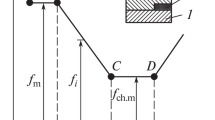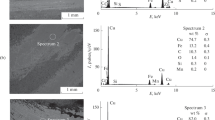Conclusion
The analysis of two-layer lubrication, metal cladding, and selective transfer in friction indicate the unified nature of these processes, which consist of formation of a sublayer of soft material on the friction surface and the SF molecules adsorbed on it. However, an effective decrease in the friction coefficient and wear rate is not attained in all cases.
The realization of high performability of a friction unit in two-layer lubrication involves a set of processes in the contact zone of the rubbing bodies. The analysis of the antifriction and antiwear effect of lubricants, based on the fundamental premises of the molecular-mechanical theory of friction and thermodynamics of solids, showed that in a certain range of unit contact loads, lubricants do not have a high antiwear effect and are inferior to the characteristic antiwear additives, which do not have an antifriction action. This is due to the formation of lubricating media which ensure two-layer lubrication on the friction surfaces of the layers which are prone to disintegrate to a great degree, i.e., which have low hardness and strength.
In friction in conditions of selective transfer, the formation of a soft layer on the friction surface is determined by the features of the effect of the medium on the deformed surface layer and the direction of the structural and phase transitions in the region of the deformed antifriction alloy. The diffusion processes caused by stress and strain gradients, mass transfer, and the activity of the medium, which are a function of many factors, including external factors (pressure, velocity, temperature, etc.), can inhibit or restrict the processes required for realization of the positive effect of two-layer lubrication, including the phenomenon of selective transfer.
Similar content being viewed by others
References
F. P. Bowden and D. Tabor,The Friction and Lubrication of Solids, Oxford University Press, London (1958).
I. G. Fuks and I. A. Buyanovskii,Introduction to Tribology [in Russian], Neft’ i Gaz, Moscow (1995).
G. I. Fuks,Trenie Iznos,4, No. 3, 398–414 (1983).
G. I. Fuks, Z. A. Kuteinikova, and M. M. Blekherov, in:Studies in the Physical Chemistry of Contact Interactions [in Russian], Bashkirskoe Knizhnoe Izd., Ufa (1971), pp. 79–93.
N. M. Alekseev and N. A. Bushe,Trenie i Iznos,6, No. 6, 965–974 (1985).
D. N. Garkunov,Tribotechnology [in Russian], Mashinostroenie, Moscow (1989).
A. S. Kuzharov and N. Yu. Onishchuk,Properties and Use of Metal-Cladding Lubricants [in Russian], TsNIITEneftekhim, Moscow (1985).
A. S. Kuzharov and O. V. Visenko,Trenie i Iznos,13, No. 2, 317–323 (1992).
S. E. Kaminskii, Candidate Dissertation, I. M. Gubkin State Academy of Oil and Gas, Moscow (1992).
D. N. Garkunov (ed.),Selective Transfer in Heavily Loaded Friction Units [in Russian], Mashinostroenie, Moscow (1982).
V. Ya. Kusochkin and B. A. Livshits,Trenie i Iznos,5, No. 5, 882–888 (1984).
E. S. Forbes,Tribology,3, 145–152 (1970).
T. Sakurai,Probl. Treniya Smazki,103, No. 4, 1–14 (1981).
Yu. S. Zaslavskii,Tribology of Lubricants [in Russian], Khimiya, Moscow (1991).
J. M. Georges, in:New Directions in Tribology, I. M. Hutchings (ed.), MEP, Bury, St. Edmunds and London (1997), pp. 67–82.
A. B. Vipper, V. L. Lashkhi, R. M. Matveevskii, et al.,Khim. Tekhnol. Topl. Masel, No. 1, 56 – 58 (1981).
I. A. Buyanovskii, V. L. Lashkhi, and R. M. Matveevskii, in:Proceedings of the XI All-Union Symposium on Mechanochemistry and Mechanoemissions of Solids, Chernigov, September 11 – 14 (1990) [in Russian], Vol. 1, Chernigov (1990), pp. 120 – 121.
Y. M. Sun, S. J. Jang, L. Q. Zheng, et al.,Tribol. Intern.,23, No. 6, 438–442 (1990).
L. I. Muksenova, A. A. Polyakov, and L. M Rybakova,Vestn. Mashinostroenie, No. 1, 35 – 40 (1990).
L. M. Rybankova and L. I. Kuksenova,Structure and Wear Resistance of Metal [in Russian], Mashinostroenie, Moscow (1982).
Author information
Authors and Affiliations
Additional information
Translated fromKhimiya i Tekhnologiya Topliv i Masel, No. 1, pp. 33 – 39, January – February, 2000.
Rights and permissions
About this article
Cite this article
Buyanovskii, I.A., Kuksenova, L.I., Rybakova, L.M. et al. Some specific methods of organizing two-layer lubrication. Chem Technol Fuels Oils 36, 37–47 (2000). https://doi.org/10.1007/BF02725246
Issue Date:
DOI: https://doi.org/10.1007/BF02725246




